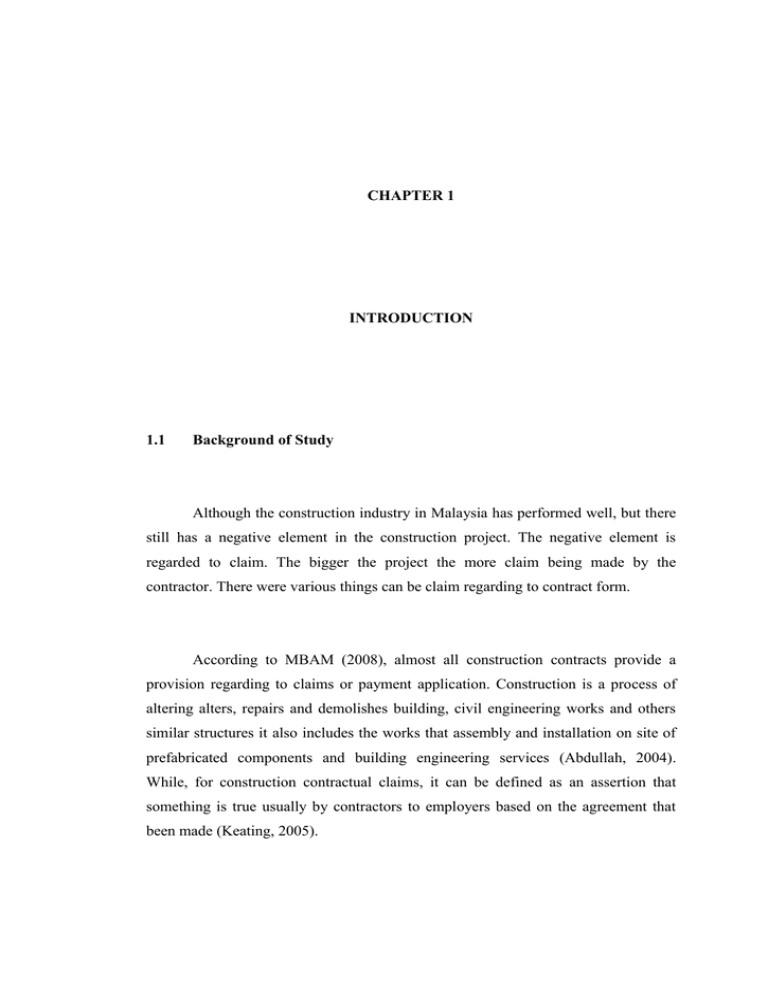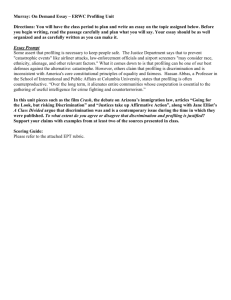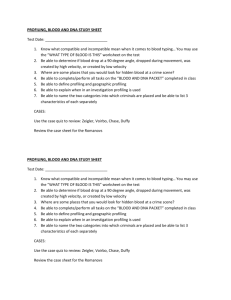CHAPTER 1 INTRODUCTION 1.1
advertisement

CHAPTER 1 INTRODUCTION 1.1 Background of Study Although the construction industry in Malaysia has performed well, but there still has a negative element in the construction project. The negative element is regarded to claim. The bigger the project the more claim being made by the contractor. There were various things can be claim regarding to contract form. According to MBAM (2008), almost all construction contracts provide a provision regarding to claims or payment application. Construction is a process of altering alters, repairs and demolishes building, civil engineering works and others similar structures it also includes the works that assembly and installation on site of prefabricated components and building engineering services (Abdullah, 2004). While, for construction contractual claims, it can be defined as an assertion that something is true usually by contractors to employers based on the agreement that been made (Keating, 2005). Claim already exists long in the earlier sixties and seventies. Where, at that time contract have been made by good faith by way of handshake agreement. This resulting to the less claim back then. Nevertheless, after growth of economy and new policies have been established by the Malaysian government, the requirement to make claim grew and extended. There were many reasons how construction claims arise. Further discussion will be explained in Chapter 2. In construction, claim is becoming more inevitable and according to Klee (2014) claims is one of the most occurring events that occur in construction project. In an article written by Bob Muir PE, (2010) “Challenges Facing Todays Construction” there are many types of challenges faced by project managers especially in the legal context. In the list of challenges, it has been highlighted that claims avoidance is one of the challenges in a legal context that has to be solved by the project manager. This has become worse because of the rising number of claims in the construction industry (Bob Muir, 2010) Based on annual report done by EC Hariss (2013) through a survey in Asian construction industry, it has been found that the top five problems that occur in the construction industry are related to many things and one of the problems is claimed. Based on these top five problems, problem related to the claims was ranked as number one as the common problem faced by the Asian construction project. A year before this, a report in 2012 ranked claim as problem at number five. It can be concluded that the problem of claims in Asian construction industry is dramatically rising. The International Association Contract Management (IACCM) Europe, Middle East and Africa conference in 2010 affirmed the issue on the rising of claim problem in construction industry. Based on the research done by IACCM members the results have shown that the frequency of claims has increased by more than 30% in the last 3 years. In the discussion made, almost all the participating organizations that participate do not undertake the regular tracking and analysis of claims. It was also apparent that relatively only a few companies undertake regular review and analysis to see whether issues could be identified and resolved at an earlier stage. This shows that there was no proactive management by the industry players. Because of the unpleasant claim, they demand for more anticipated or proactive management (IACCM, 2010). 1.2 Background of the Problem The foregoing discussion suggest that there is a need to address the issues of claims. Based on the background of study it highlight a number of important issues that are 1) What are the common type of claim that have been brought to the court? 2) Who often made the claim? 3) What type of project that claim occurs and which type? 4) What are the common causes of claim? 5) What are the standard form that been used? As discussed earlier, there is a need conduct the regular tracking and analysis of claims in order to see the trend and analysis in order to minimize the problem and eliminates the source of claim at the earlier stage of construction. One of the way to do the tracking and analysis is through profiling. 1.3 Objective of Study Based on the problems encountered and research question, the objective of this study is: a) To develop profile of contractual claim in term of head of claim, causes of claim, type of project, parties involved, standard form of contract, time of claim occur and the origin of claim resolution. 1.4 Scope of the Study The scopes of this study are as follow: b) This research is limited to the objective that have been stated only. c) This study is based on claim cases in construction that have been reported by Malaysian Law Journal between 1999 until 2013 and it is strictly involving Malaysian cases only. d) Cases that are related to the “building contract” &“claim” only. e) Limited to construction contractual claim (under contract basis) only. f) Focuses on the main employer, main contractor, subcontractor and sub subcontractor claim. g) Limited to monetary claim 1.5 Significance of the Study The significance of this research is to obtain adequate information and knowledge of claim in construction. This research is made based on law cases that can fill the gap of knowledge in claims for construction industries. This information and knowledge can be referred to a better management process in the future. Project manager and contract administrator can take proactive actions by advising the parties to avoid claims from happening. This research also intend to identify the common claim that can be prevented at the early stage of the project. It is also useful in order to prevent and minimizes claim problems. Besides that, from this profile, industry players can observe the trend and pattern of the claims. And it wills help them to be more aware when they are involved in a construction project. This profile also could be a reference to the client to recognize potential claims that might occur. Client may gain information from the claims pattern and the causes of claim. With an early recognition on causes of claim it can protect the client from incurs losses. And with this research it also can give academic knowledge or information about the trend or pattern of the claim in construction for the researcher and student about the pattern of claim. 1.6 Research Methodology In order to achieve the objective that has been set out, a systematic process of conducting this research had been organized. The methodology that has been carried out through this research comprise five major stages. This can be seen on Figure 1.1 that shows the flowchart of the research methodology. Further explanation is also been given. Stage 1 Stage 2 Development of Research Proposal Develop Theoretical Framework Stage 3 Research Design and Data Collection Stage 4 Data analysis and arrangement Conclusion and recommendation Stage 5 Writing and review Figure 1.1: Research Methodology Flowchart 1.6.1 Stage 1: Development of research proposal This stage is the first stage to conduct this study. It starts with the selection of the area of study, followed by the selection of the title, statement of issues, the objectives and lastly the scope of the study. To conduct the first stage is by referring to books, theses, magazines, seminar papers and sources of electronic media and the internet is important in order to get a better understanding and get the real picture of the topics to be studied. After the development of objectives, discussions have been made with the supervisor for guidance, insight and advice about the topics. 1.6.2 Stage 2: Literature Review to Develop Theoretical Framework for the Study Literature review to develop theoretical framework can be obtained through secondary data such as reading books, conference papers, newspapers, journal articles and brochures. The literature review conducted in this research is to assist in immersing the important concepts related to the research topic and to collect the relevant information. This data was helpful in the understanding and deepen the study. Because the data is closely related to the objectives of the research study conducted. 1.6.3 Stage 3: Research Design and Data Collection The third stage is research design and data collection. Main purpose of this stage is to identify data for the research. The identified data must be associated with the research in order to meet the objectives set by the researcher. Based on the objective that has been set, the data needed comes from secondary data. The data is law cases that have been obtained from Lexis Malaysia legal database. Lexis Malaysia is an online database that provides a law case that is Malaysia law Journal. This data been collected for the analysis and arrangement. After that, further discussion has been arranged with the supervisor. 1.6.4 Stage 4: Data Analysis and Arrangement In this stage, the data and information that is obtained from stage three have been compiled and reviewed to get the results of the study in order to meet the objectives. Next, the data have been analysed and been interpreted to graphs, tables and pie charts. Further explanation can be seen in the Chapter 3 Profiling. 1.6.5 Stage 5: Conclusion and Recommendation The last stage is to conclude the data that had been obtained through this research, where by all the finding will be stated in this stage. After that, the recommendation for the next research has been written down. 1.7 Organisation of Thesis Chapter This study will consist of five chapters. The brief descriptions of each chapter are as follows: 1.7.1 Chapter 1: Introduction This chapter is the research proposal. It introduces the background of the study, problem statement, objective and scope of study. It also includes the research methodology in order to achieve the objective of the study. 1.7.2 Chapter 2: Theory of Claim in Construction Industry This chapter generally discussed about claim in construction industry. It includes the definition of claim, type of claim, effect and the implication of the claim and other data that are relevant to claim in construction. This chapter also discusses about the nature of construction industry, the technical aspects which include various of parties and activities involved in construction and also discuss a part of legal aspect which discuss the terms and conditions of the contract where both aspects have probability resulting in claim problems in construction. 1.7.3 Chapter 3: Profiling Chapter three describes the research methodology in detail. This chapter will discuss about profiling method which include the definition of the profiling, the importance of profiling. In this chapter it also highlights the instrument for the profiling method. 1.7.4 Chapter 4: Profiling of Construction Claim In this chapter, a profile of the contractual claims data has been made. The analysis was done to determine whether the objectives of the study are set out in Chapter One (1) is been reached or not. The profile indicate the relevant cases according to the type of project, which has been further divided according to the parameter that been set out in the Chapter 3. 1.7.5 Chapter 5: Analysis of the Profile This chapter is the analysis of the profile that has been made in the Chapter 4. The analysis made is in the form of graphs, pie chart and others. The function of these analysis of the profile is to make it easier for readers to read. The analysis has been made by the computer via software like Microsoft Excel. 1.7.6. Chapter 6: Conclusion and Recommendation This is the last chapter of this research. This chapter contain a summary of the results. The conclusions or summary are drawn based on the results obtained from this study. Recommendations for further research is provided in this chapter.





